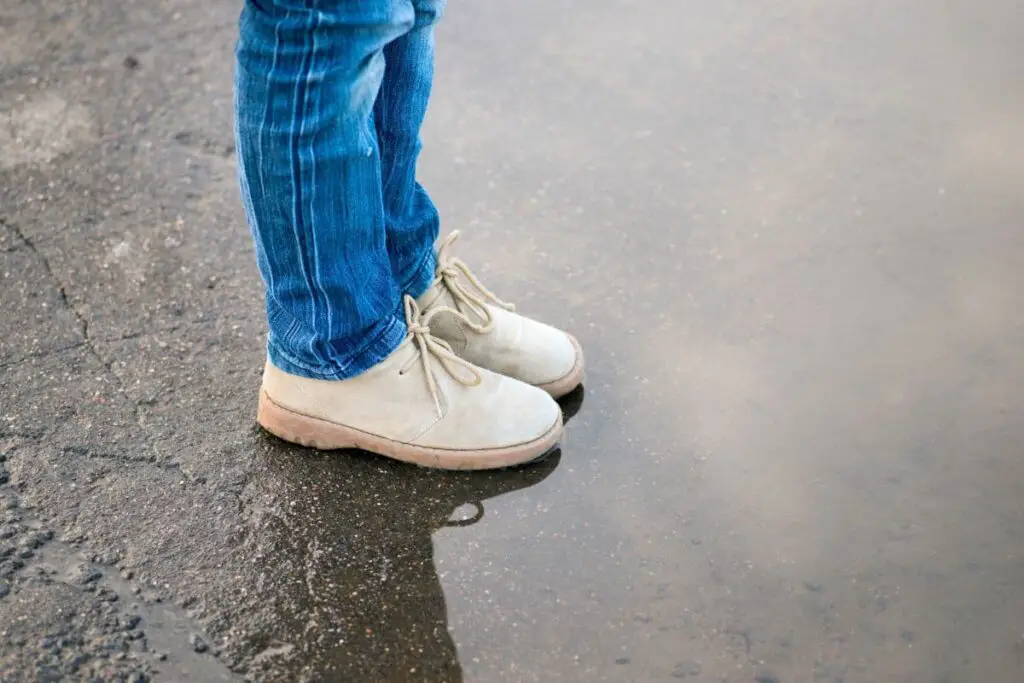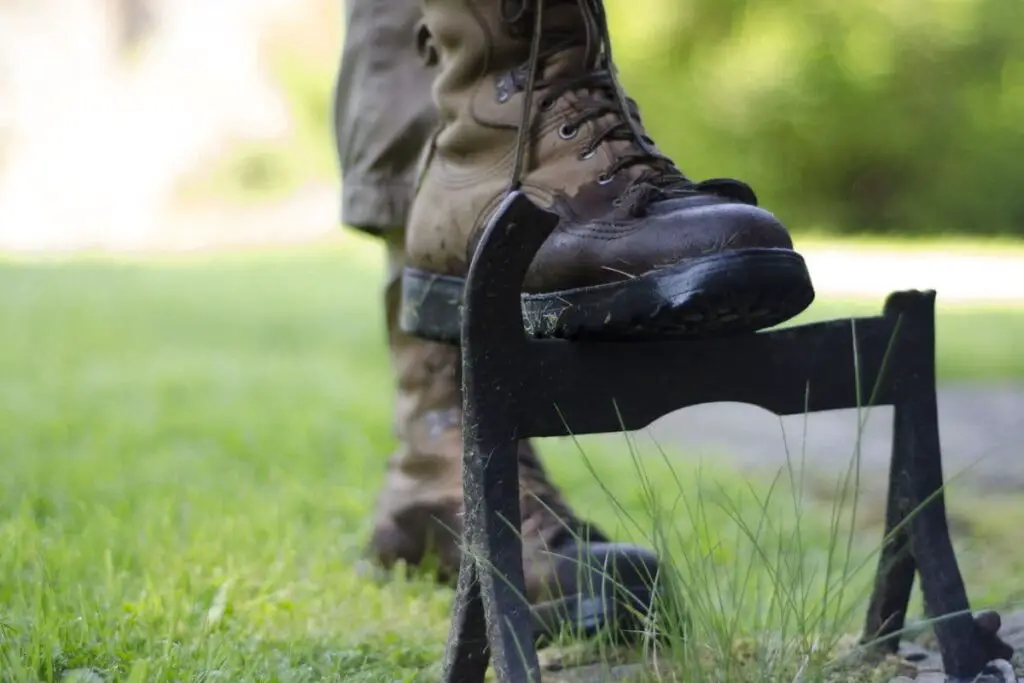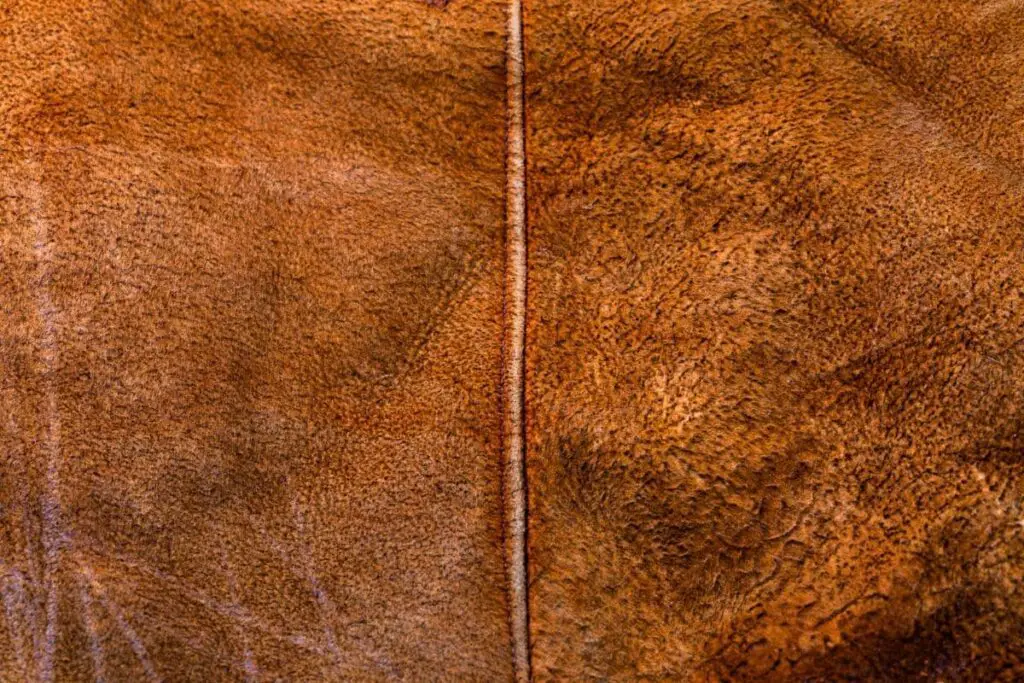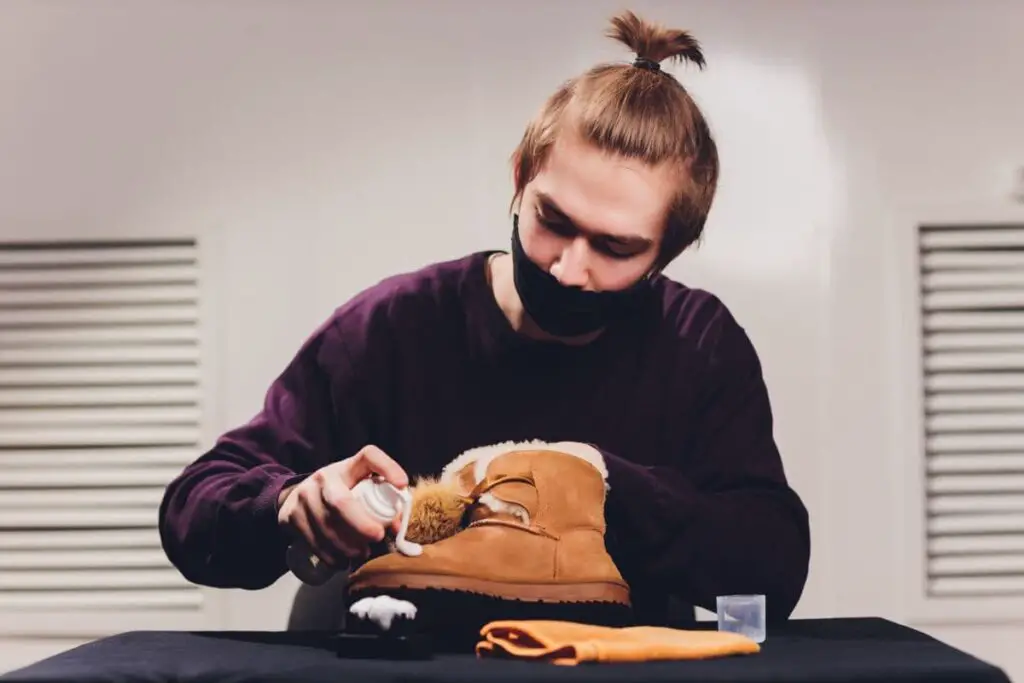As an Amazon Associate, we earn from qualifying purchases. We may also earn commissions if you purchase products from other retailers after clicking on a link from our site.
Suede fabrics are known for their soft texture and luxurious appearance. They can also last several years with proper care, but is suede durable enough to be worn in wet weather?
You can’t wear suede in the rain. The fabric contains delicate fibers that can become damaged or dull after exposure to water. It’s not easy to clean and restore mud-stained suede clothing or shoes.
This article will explain the consequences of wearing suede in the rain and give tips on protecting your suede pieces in wet weather. Read on to find out more.

Will Rain Damage Suede?
Water and suede don’t mix, so even a light rain shower can leave your suede damaged or looking dull. It’s best to avoid wearing suede shoes or clothing in wet weather, as the rain can affect your suede pieces in various ways.
Rainwater Causes Suede To Lose Its Shape
Suede contains fibers that swell when exposed to rainwater, which causes the material to lose shape. Suede may also become stiff and rough instead of soft and supple.
One of the reasons why rainwater is particularly hard on suede is that it’s often accompanied by dirt and other debris that can become embedded in the fabric. To prevent permanent damage to your suede items, you must take extra care of them when they get wet.

Regular cleaning and conditioning can also help prevent damage.
Rainwater Can Stain and Discolor Suede
Besides losing its shape, suede can also become stained and discolored from rainwater. Unlike leather, suede has no protective layer, so stains can seep into the fabric and be difficult to remove.
The following chemicals and substances in rainwater can stain or discolor suede:
- Traces of salt: Rainwater often contains traces of salt, which can lead to discoloration or leave white marks on the material.
- Dirt and mud: Rain can bring dirt and mud, leaving dark stains on suede. For example, if you accidentally step in a puddle while wearing suede shoes, the mud may stain the material.
- Acid: In some areas, rain can be acidic due to air pollution. Specifically, that type of rain contains sulfuric acid, which can cause discoloration or yellowing of the fabric.
Rainwater Encourages Mold and Mildew Growth
If your suede gets wet and isn’t properly dried, it may develop mold or mildew growth, which can degrade the material and leave a musty odor. Additionally, mold and mildew can cause health issues if you wear the affected item.

For example, if you wear a moldy suede jacket, you may inhale the mold spores and experience respiratory issues. To prevent these problems, you must clean and dry wet suede items as soon as possible.
Rain Causes Suede To Lose Its Shine
Suede has a unique, attractive sheen that adds to its luxurious appearance. However, when exposed to rainwater, suede fibers can lose their shine and become dull. You may spot watermarks on the material, which can detract from its overall appearance.
What To Do When Suede Shoes Get Wet
Suede shoes are susceptible to dirt, water, and stains. If they are not properly cared for, they can become discolored and damaged. These shoes require special care and attention.
Here’s how to take care of your wet suede shoes:
- Take the shoes off as soon as possible. Allowing your shoes to stay wet will only make the problem worse and could potentially damage the shoes beyond repair.
- Blot the excess water. If you’re caught in the rain with your suede shoes on, resist the urge to rub them dry. Rubbing your suede shoes will only spread the water and damage the fabric. Instead, blot the shoes with a clean, dry cloth to absorb the moisture.
- Stuff the shoes with paper towels. Doing so helps to absorb any remaining moisture. It’s important to use paper towels rather than other materials, as they will not leave behind any lint.
- Let the fabric dry naturally. Allowing your suede shoes to air dry will prevent foul odor. However, suede fabrics dry slowly, so be patient. Don’t place your shoes under direct sunlight or near any other heat source, such as a hair dryer, as high temperatures can damage the fabric.
- Brush away any dirt or debris. Once your shoes are dry, use a soft-bristled brush to scrub away any dirt or debris the water may have left behind.
- Apply a waterproofing spray. Waterproofing sprays create an invisible barrier that repels water and stains and can extend the life of your shoes by protecting them from exposure to water and dirt.
For waterproofing, you can try the Simple Shine Shoe Protector Spray from Amazon.com. It’s specifically made for suede shoes and can also be used on other materials, such as leather. Additionally, it’s dye-free and won’t darken your shoes, making it a safe option for any color of suede.
Suede Care and Maintenance Tips
Nobody wants to have their suede shoes or clothing damaged or stained in the first place. After all, it can be expensive to replace them. Consider the following tips for maintaining and caring for your suede items.

Avoid Wearing Suede Clothing in Wet Weather
Leaving your suede clothing or shoes at home is the best way to prevent any potential damage or stains caused by rainwater. Suede is very sensitive to moisture and can be easily damaged by rainwater.
As a rule, suede should not be exposed to moisture or dampness, including rain, snow, humidity, and even sweat.
Store Suede Items in a Dry Place
When you’re not wearing your suede items, they should be stored properly. Protect your suede items by storing them in a cool, dry place away from direct sunlight. Suede tends to soak up moisture from the environment, which can cause it to become stiff and brittle.
You can also stuff your suede shoes to keep their shape and prevent creasing. However, don’t use socks when stuffing your shoes, as paper towels are the best option. Just make sure to stuff them loosely so your shoes can still breathe.
Here are a few essential guidelines for storing suede shoes:
- Don’t store suede shoes in plastic bags. Plastic traps moisture, which can lead to mold and mildew growth. Instead, use a cloth or canvas bag for storage.
- Don’t stack heavy items on top of suede shoes in storage. Doing so can cause them to become misshapen or creased.
- Store the shoes in a cool, well-ventilated area. Avoid storing them in a damp basement or garage to reduce the chances of water damage.
Wear Suede Shoes in Rotation
Instead of wearing the same suede shoes daily, try rotating between pairs, as this allows the shoes to air out and prevents excess sweat or moisture from building up. It also helps you avoid foot odor or infections.
Additionally, resting for a day or two allows your shoes to regain their shape before being worn again, which helps them last longer.
Regularly Clean and Condition Your Suede Items
It’s important to regularly clean and condition your suede items to maintain their appearance and prolong their lifespan. You may use a soft-bristled brush or toothbrush to remove dirt or debris. Invest in a specialized suede cleaner and conditioner for the best results.
Here are a few guidelines for choosing and using a suede cleaner and conditioner:
- Check the product’s instructions before using it on your suede items. Some may require dilution with water, while others can be applied directly to the fabric.
- Test the cleaner in an inconspicuous area first. You can apply just a small amount on the inside of a shoe or the inside seam of a jacket to ensure the product doesn’t discolor or damage the fabric.
- Follow up with a conditioner or waterproofing spray after cleaning. Doing so restores moisture and keeps your suede shoes or clothing soft and supple. You can also apply a waterproofing spray to your suede items to prevent water damage.
Most importantly, always let your suede items dry fully before wearing or storing them, as this prevents potential staining or damage from moisture. And if the inevitable ever happens and you find yourself in a situation where you must wear suede shoes in the rain, be sure to take the following steps to minimize the damage:
- Cover yourself with a waterproof coat or umbrella to protect your clothing and shoes.
- Avoid puddles, as stepping on them can cause the suede to become stained or discolored.
- As soon as possible, remove any excess moisture from your shoes with a dry cloth and allow them to dry fully before storing or wearing them again.
Here’s an excellent video with tips on how to clean and care for suede shoes:
The Bottom Line
Rain, snow, and other types of wet weather do not go well with suede. It’s best to avoid wearing or exposing your suede items to moisture at all costs, as it can cause stains, discoloration, and damage to the fabric.
On the contrary, proper storage, rotation, and regular cleaning and conditioning can help extend the lifespan of your suede items and keep them looking their best. And if you find yourself wearing suede in wet conditions, be sure to protect it as much as possible by cleaning and drying it immediately afterward.
